The
Sydney tramway network In its heyday was the largest in Australia, the second largest in the Commonwealth of Nations (after London), and one of the largest in the world. It was extremely intensively worked, with about 1,600 cars in service at any one time at its peak during the 1930s . Throughout the first half of the twentieth century, an average of more than one tram journey per day was made in
Sydney by every man and woman, infant and child in the city. Patronage peaked in 1945 at 405 million passenger journeys. The system was in place from 1879 until its winding down in the 1950s and closure in 1961 (a single horse-car line operated from 1861 to 1866). It had a maximum street mileage of 181
miles in 1923.
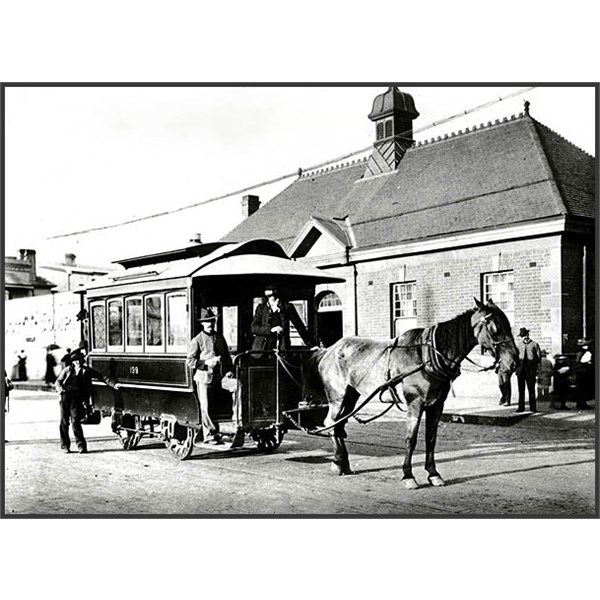
Horsedrawn tram which ran between Newtown Station and St Peters, c1894
's first tram was horse-drawn, running from the old
Sydney Railway station to
Circular Quay along Pitt Street. Built in 1861, the design was compromised by the desire to haul railway freight wagons along the line to supply city businesses, in addition to passenger traffic. This resulted in a track that protruded from the road surface and damaged the wheels of wagons trying to cross it. Hard campaigning by competing omnibus owners - as
well as a fatal accident involving the leading Australian musician Isaac Nathan in 1864 - led to closure in 1866.
Isaac Nathan was a passenger on No. 2 tramway car, he alighted from the car at the southern end, but before he got clear of the rails the car moved onwards , he was thus whirled round by the sudden motion of the carriage and his body was brought under the front wheel. He was Australia's (indeed the southern hemisphere's) first tram fatality. He was buried at Camperdown
Cemetery.
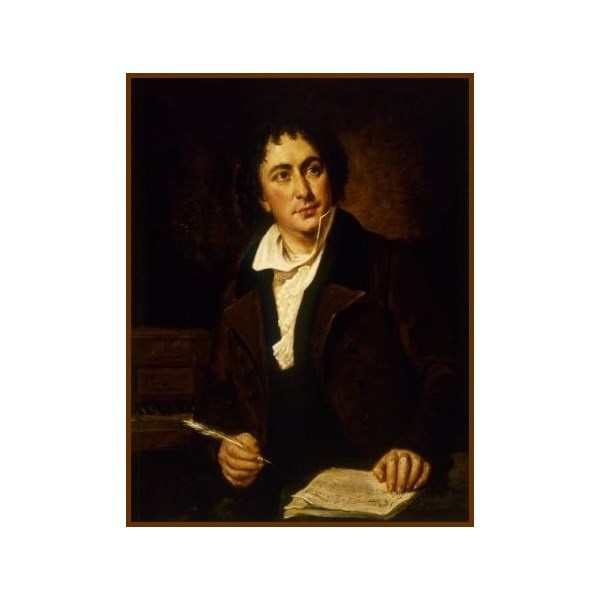
Isaac Nathan c. 1820
In 1879 a steam tramway was established. Despite several accidents, it was a great success and the system expanded rapidly through the city and inner suburbs. The Steam Motor Trams comprised a Baldwin locomotive hauling one or more double-deck carriages. A preserved Baldwin Steam Motor Tram is at the Powerhouse Museum "Discovery Centre" at
Castle Hill, and there is an operational steam motor and trailer set at the Valley Heights Steam Tramway Museum, in the Blue Mountains near
Sydney. There were also two cable tram routes, to Ocean Street (Edgecliff) and in North
Sydney, later extended to Crows Nest, because of the steep terrain involved.
Additionally, horse trams operated between Newtown and St Peters railway stations in the 1890s and between Manly and North Manly from 1903 to 1907. These two instances were replacements of existing steam trams during periods of low patronage
The
Sydney tram power supply system was built using New
York subway electrical equipment that was adapted for tram usage. Generating plant was installed at Ultimo and White Bay Power Stations.

Early model electrified trams on George Street near Hunter Street
Electrification started in 1898, and most of the system was converted by 1910- the privately owned Parramatta line built by Charles Edward Jeanneret in 1881 to Redbank Wharf (Duck River) steam tram remained until 1943. Service began with C-class saloon cars, followed by D-class combination cars. In contrast to other cities that started with combination cars and toastracks, then quickly abandoned them for drop-centre and saloon cars,
Sydney started by going the other way. Footboard trams continued to be introduced, notably E-class, K-class, and the double-bogie cars O-class and P-class trams required the conductor to collect fares from the footboard of the car, as those trams had no corridor. Revered though those trams were, they were deathtraps for conductors. On average, each day one conductor fell or was knocked off the footboard by passing motor vehicles. The majority suffered a fractured skull. In the three years 1923, 1924, 1925, there were 282, 289, and 233 accidents respectively to conductors on N.S.W. tramways. From 1916 to 1932, there were 4097 accidents to tram employees, and from 1923 to 1931 there were 10,228 accidents to passengers having falls when alighting or boarding. 63 of the falls were fatal. Of the more than 100 falls reported of conductors, one quarter died from their injuries. It was not until the 1930s with the introduction of the R-class that the drop-centre saloon tram, widely used elsewhere in Australia, came to
Sydney. Even so, footboard trams continued in wide use until the late 1950s, despite calls as early as 1934 by the tram union for them to be modified.
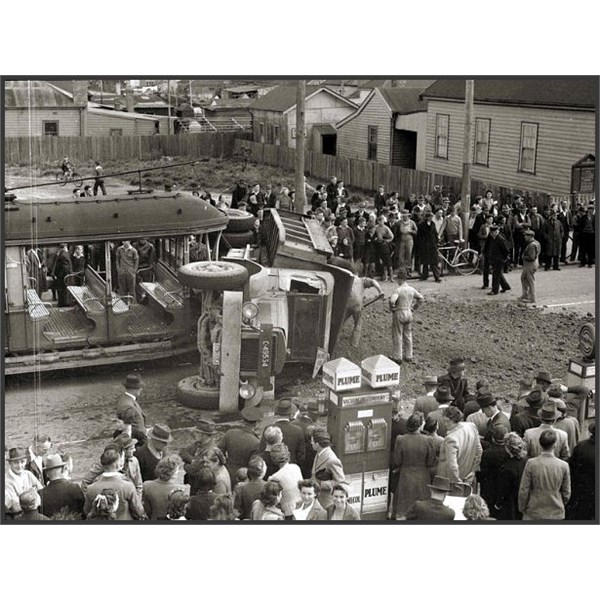
Botany Road, Mascot, collision between a truck and K-class tram
By the 1920s, the system had reached its maximum extent. In many ways, the
Sydney tram system was a victim of its own success. The overcrowded and heaving trams running at a high frequency, in competition with growing private motor car and bus use, created congestion. Competition from the private car, private bus operators and the perception of traffic congestion led to the gradual closure of lines from the late 1930s. Overseas transport experts were called upon to advise the city on its post-war transport issues and recommended closure of the system. Closure was supported by the NRMA, but generally went against public opinion. Nevertheless, closure became Labor government policy and the system was wound down in stages, with withdrawal of the last service, to La Perouse, in 1961, which was driven by Jerry Valek, a Czechoslovakian man from
Annandale.

3 Railway Square tram interchange circa 1930
This was an extremely busy service for passengers transferring from suburban trains at Central, particularly prior to the opening of the city underground railway lines in 1926. Trams operated from
Central station down Castlereagh Street to
Circular Quay and back up Pitt Street in a large anti-clockwise loop. These tracks were also used as the city route for some eastern and southwestern routes during busy periods. The line made use of the
sandstone viaduct onto the colonnade at
Central station, used by the Inner West Light Rail since 1997, but in the opposite direction.
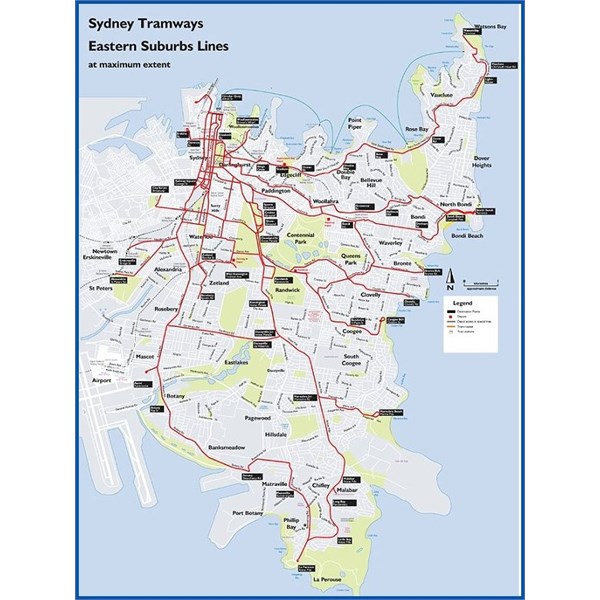
Eastern Suburbs Lines map
was the focal terminal point of most
services to the eastern suburbs, and allowed easy transfer to ferries. For many years, 27 regular
services operated from
Circular Quay. A number of full-time
services also operated from a secondary terminus at 'Railway' (Railway Square at
Central Station).
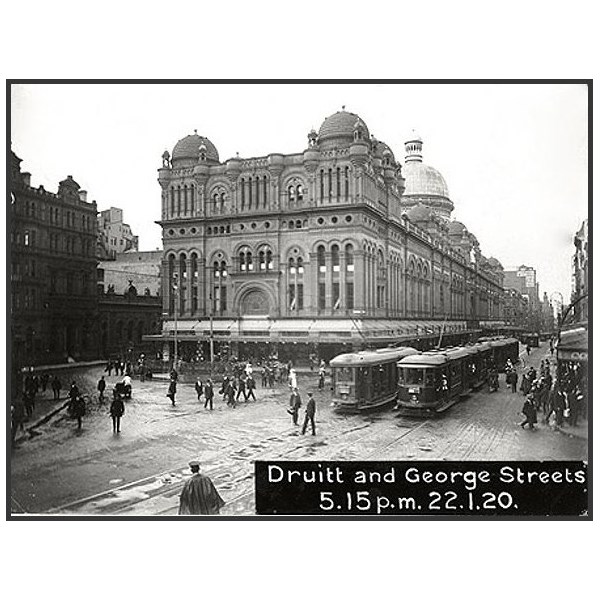
Trams on George Street, 1920
Heading south down Elizabeth Street from
Circular Quay, the line turned left into
Park Street, then wound through East
Sydney via a right turn into Yurong Street, a left turn into
Stanley Street, a right turn into
Bourke Street, then a left turn into Burton Street. According to plans held in the archives of the City of
Sydney a spur line existed linking Burton Street to the prisoners entrance on
Forbes street at the rear of the Darlinghurst Courthouse. This may have allowed prisoners from Long Bay Gaol or elsewhere to be transported by tram to Darlinghurst Courthouse . A feature was the tram only viaduct over Barcom Avenue and
Boundary Street in Darlinghurst as the line headed into MacDonald Street. This viaduct is now a road bridge. The line then twisted down Glenmore, Gurner and Hargreave Streets in Paddington, then Moncur and Queen Streets in Woollahra. Here, a connection to Oxford Street allowed access to the Waverley Depot. The line then travelled down Edgecliff and Victoria Roads, then wound along Birriga Road in Bellevue
Hill, finally running down Curlewis Street in Bondi to join the Bondi Beach via Bondi
Junction line on Campbell Parade, to the North Bondi terminus. The line was double track throughout with numerous points to allow short working.
Services operated from
Circular Quay via Elizabeth Street and
Park Street. The line opened to Bellevue
Hill in 1909, and to Bondi Beach in 1914. The line was cut back to Ocean Street, Woollahra in 1955; the remainder closed on 27 June 1959. The line followed approximately the current route of bus 389 between the city and Woollahra and route X84 between Woollahra and Bondi Beach.
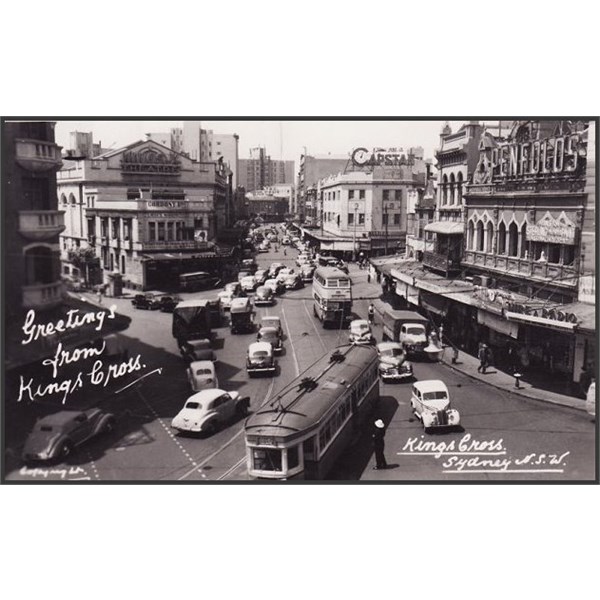
Kings Cross 1950
This line branched from Oxford Street at Taylor Square in Darlinghurst to run south along Flinders Street, then into its own tram reservation along the eastern side of Anzac Parade beside Moore
Park. It then proceeded down the centre of Anzac Parade through Maroubra
Junction, and Malabar to its balloon loop terminus at La Perouse. At Malabar a single line branched off to serve Long Bay Gaol. The line was double track throughout. In 1934 the fourth section of the La Perouse tramline was built to Bunnerong Power Station in Matraville to encourage residential and industrial growth in the area. The line reached La Perouse in stages from 1900 to 1902. It was the final line to close in 1961.
From either Railway Square or
Circular Quay services ran along Broadway and Parramatta Road. At Forest Lodge the line swung right into
Ross Street before entering onto its own reserved track, now known as Minogue Crescent, passing Rozelle Tram Depot. Turning right onto Commercial Road (now City West Link Road) and left onto Victoria Road, the tram then crossed the Iron Cove Bridge and the former Gladesville Bridge before turning right onto Blaxland Road. It then wound its way along Blaxland Road, behind the sight of the current council chambers, terminating near the
intersection of Pope and Devlin Street in Ryde. It was initially a single line, later duplicated from Rozelle to Ryde between 1906 and 1936. The tram terminus was established at the western end of Blaxland Road, located near the current Top Ryde City shopping centre, and extended down Victoria Road through Gladesville, where it eventually terminated at Fort Macquarie (present site of the
Sydney Opera House). The entire trip took approximately 61 minutes to complete, and was the single longest route on the
Sydney tram network, measuring 10
miles 61 chains (17.3 km) via Pyrmont. In 1914 a single tram line was added between Ryde
Post Office (corner of Church Street and
Parkes Street) and West Ryde railway station. The
Sydney to Ryde service became very popular, particularly at weekends when
Sydney residents would travel to the orchards of the Ryde District to buy produce. The tram service from Ryde to the city was terminated on 19 January 1949 and replaced by buses.

South-western and western lines map
The Southwestern group of lines branched off Broadway at City Road in Camperdown, and passed along King Street through Newtown. Four lines then proceeded to Cooks River, Dulwich
Hill, Canterbury and Earlwood. A short lived line also operated between Canterbury and Summer
Hill. This line ran south-west along City Road from Broadway, then along King Street, Newtown, past Newtown and St Peters railway stations to the Princes Highway. It then proceeded down the Princes Highway to its terminus at the Cooks River. At Tempe, a connection lead to the Tempe Depot, on the corner of Princes Highway and Gannon Street. Past the terminus at the Cooks River, a single line led over the river to the Wolli
Creek Perway Yard. The line reached St Peters as a steam tramway in 1891, then to Cooks River in 1900 when electric
services commenced. The line closed in 1957, and bus 422 parallels the former line.
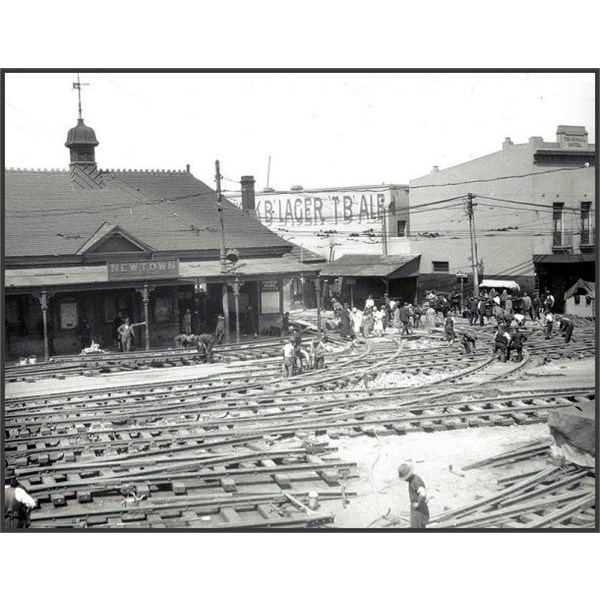
Relaying tracks in Newtown 1927
A cross country connection between the Canterbury Line at New Canterbury Road to Petersham and the Western Suburbs lines on Parramatta Road allowed a cross country service to operate between Canterbury and Balmain. From Crystal Street, Fort Street (single line loops), Parramatta Road, this route continued via Norton Street Leichhardt to Balmain Road Rozelle where it crossed Victoria Road, then Darling Street Wharf, East Balmain, to reach
the wharf itself with the help of the famous counterweight. It now forms the basis of the 444 and 445 bus routes.
From
Circular Quay trams reached Newtown via Catlereagh Street (Pitt Street to the Quay) Broadway, City Road, King Street, then headed south on Enmore Road the tram turned right into Addison Road, before turning right into
Livingstone Road and then left onto New Canterbury Road in Petersham. The line then travelled down New Canterbury Road through Dulwich
Hill and Hurlstone
Park to a terminus adjacent to Canterbury railway station in Broughton Street. The bus route 428 follows the route of this line.
This line opened as a private steam tramway in 1885. It was electrified in 1900, and moved into government ownership in 1914. The line connected with the trains at Rockdale station, then passed down Bay Street to
Brighton-Le-Sands. The line was single track throughout, with a passing loop at each end. The line closed in 1949 and was replaced by a bus service. A small depot in Rockdale maintained the cars.
This steam tramway opened in 1887 using small railway locomotives and carriages. In 1891 two conventional steam tram motors were built for the line by Henry Vale. Six C1 type trailers replaced the railway carriages around the same period. The tramway operated for 50 years until it was replaced by an electric trolleybus service in 1937. It connected with trains at Kogarah station by way of a large balloon loop through the streets, then passed south down
Rocky Point Road to Sans Souci, Sandringham and Dolls Point. Small depots at Sandringham and Kogarah serviced the line. The line was single track at each end with a double-track middle section down
Rocky Point Road. Track on the line was laid to railway standards to allow railway trucks to haul goods over the line.
Wilson's 1917 map shows the route leaving Kogarah Station (no loop), then Gray Street, across Kogarah Road, and thence by a ROW to
Rocky Point Road, entering near Herman Street, thence along Russell Avenue, Clareville Street to the foreshore, then along the foreshore (now
Cook Park) to Sans Souci/
Rocky Point Road, then north along that road, rejoining the line at Russell Avenue.
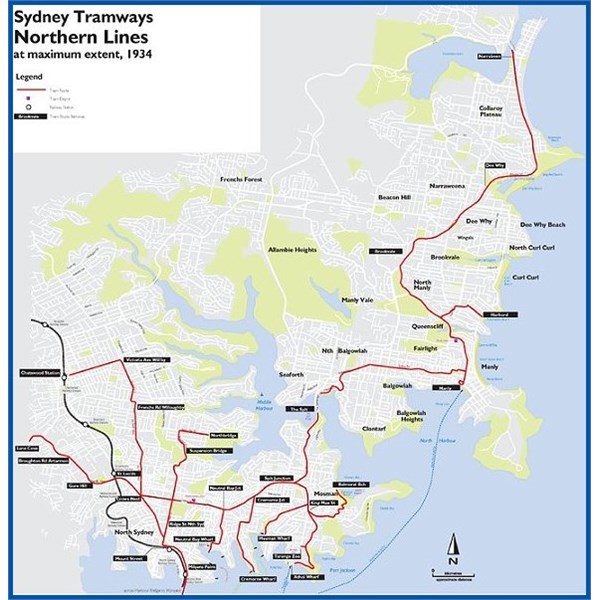
North Shore Lines map
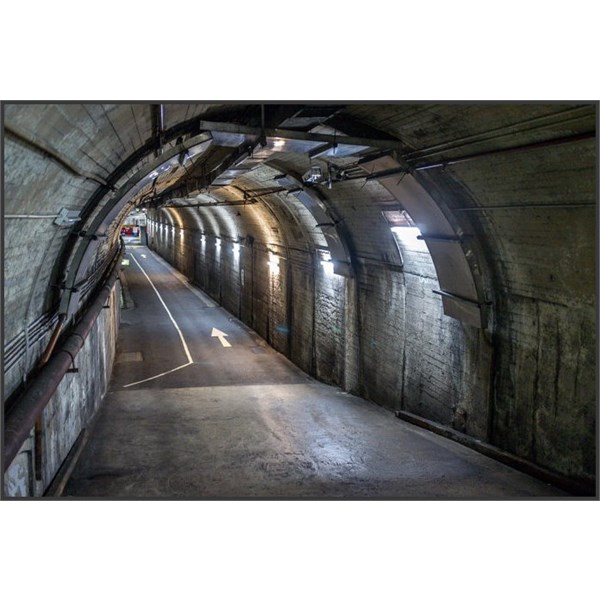
Former Tram Tunnel leading to disused Platforms 1 and 2 at Wynyard Station
Former Tram Tunnels leading to disused Platforms 1 and 2 at Wynyard Station
A feature of these lines was the underground tram terminus at Wynyard railway station (the only one in Australia), and the tracks over the
Sydney Harbour Bridge. Trams ran from Blue Street, North
Sydney over a now-demolished steel arch bridge over the Harbour Bridge Roadway, then over the eastern side of the harbour bridge (now road lanes), through a tram platform at Milsons Point similar to the existing railway station, and dived underground into platforms 1 and 2 of Wynyard station. These platforms were converted into a car
park after the tramway's closure in 1958. Wynyard station's railway platforms are thus numbered 3-6.
The line along Military Road, opened in September, 1893, was the first permanent electric tramway in
Sydney and New South Wales.
The first part of the North
Sydney tramway system was a double-track cable tramway which started at the original Milsons Point Ferry wharf, located where the north pylon of the Harbour Bridge is now. The line originally extended via Alfred Street (now Alfred Street South),
Junction Street (now Pacific Highway), Blue Street and Miller Streets to the winding engine house and depot at Ridge Street. It used cable grip cars called "dummies" and unpowered trailer cars, similar to the large
Melbourne cable tramway system but quite different from the surviving lines in San Francisco, where everything is combined in a single vehicle.
The original cable line was extended via Miller and Falcon Streets to Crows Nest, and later the whole line was electrified and extensions were built to various termini around the Lower North Shore. The history of the North
Sydney tramway system can be divided into three periods - the first from the original opening in 1886 to 1909, when the McMahons Point line opened. The second period covers the time until the Wynyard line was opened across the
Sydney Harbour Bridge in 1932, and the third from then until the general closure of the system in 1958.
The Enfield system was a separate group of lines based around a depot in Enfield, in
Sydney's inner southwest. The system began as a steam tramway opening in 1891 between Ashfield Station and Enfield. In 1901, this line was extended north to Mortlake, and in 1909 a branch to Cabarita
Park was opened. The system was electrified in 1912.
Services operated from Ashfield Station along Liverpool Road, Georges River Road, onto a reserved corridor that swung off Georges River Road at a point roughly opposite Windsor Avenue. From this point the corridor ran diagonally towards, then across Burwood Road and onto what is now Tangarra Street East. The reserved corridor ended at
Portland Street, at which point the line continued west along the length of Tangarra Street, then north along what is now Coronation Parade (the two parallel streets were originally known as, from east to west, The Boulevarde and Punchbowl Road), back to Liverpool Road heading east through Enfield, and then north along Burwood Road through Burwood. The line then turned into Crane Street, then Majors Bay Road and Brewer Street to Cabarita
Junction. The line was double track until this point, then it split into single-track branches to Mortlake via Frederick, Vanhee and Gale Streets and Tenneyson Road, and to Cabarita via Cabarita Road. Short
services were turned back at
Brighton Avenue, Plymouth Street, Enfield, Burwood Station and Wellbank Street.
Services operated every five minutes between Ashfield and Wellbank Street in peak periods, and every 15 minutes (30 minutes at off-peak times) on the two branches.
A depot on Tangarra Street, near Kembla Street and Coronation Parade, served the lines. The lines closed in 1948, and were replaced by buses. Tramway
infrastructure was removed throughout the route in 1951. The Tangarra Street depot was used by buses until its closure in 1989. The depot was demolished to make way for housing. A small brick hut used as a waiting room for passengers still stands on the western side of the Coronation Parade reserve near Dean Street. This is one of very few surviving remnants of the line.
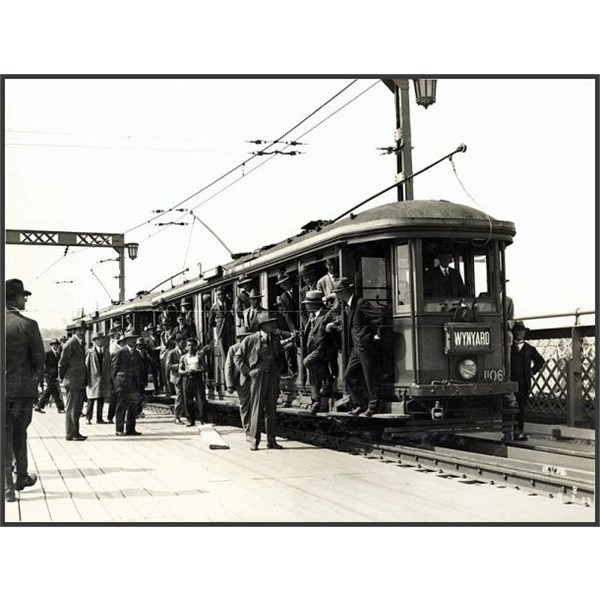
'O' Class 'Toastrack' at Sydney Harbour Bridge Opening
In 1905 a general alphabetical classification was introduced to the NSW Government Tramways. Generally the letters A and B were given to steam stock with letters C and higher to electric cars based on seating capacity. Perhaps the most renowned of the electric trams that operated in
Sydney were the O and P class trams, known at the time as the footboard cars, after the surrounding footboard that conductors precariously balanced upon. These were later known as toastrack trams for their crossbench wooden seating layout. They had a seating capacity of 80 and a crush capacity of 150, and it was this capacity that was their selling point for
Sydney's crowded system. They were commonly coupled together to run as double trams. 626 O class and 258 P class trams were constructed from 1908, and some remained in service until 1960.
The first modern corridor style trams, the R class, were introduced in 1933. The final order of cars was for the R1 class in the early 1950s. The R class were unable to be coupled together.[48] The R series offered their passengers a more comfortable ride away from the elements, and featured mostly upholstered seating. Some of these cars had not been in service long enough for a major overhaul before their withdrawal in the late 1950s and early 1960s.
Upon withdrawal, most cars were stripped of their metal components and bogies, then burnt in an area of the Randwick Tramway Workshops known as 'burning
hill'. Some were sold as stripped shells to private users to be used as shelters, storage shed, etc. Some were preserved, mostly at
Sydney Tramway Museum at Loftus.
Accidents
On 21 August 1924, a coupled set of E class cars ran out of control near McMahon's Point, derailed and crashed into a house. There were two fatalities, and the trams were extensively damaged.
In 1929, a P class tram crashed into a barber's
shop on the corner of Quay and Ultimo Roads near
Central Station. Almost half of the tramcar ended up in the
shop.
There were accidents at Athol Wharf, Taronga
Park, when trams lost control running down the steep
hill and ended up in the harbour, in 1942, 1952 and 1958.
Locomotive workshops were established at King Street Randwick in 1881 to build and service
Sydney's trams. In 1902 the workshops were renamed the Randwick Tramway Workshops.
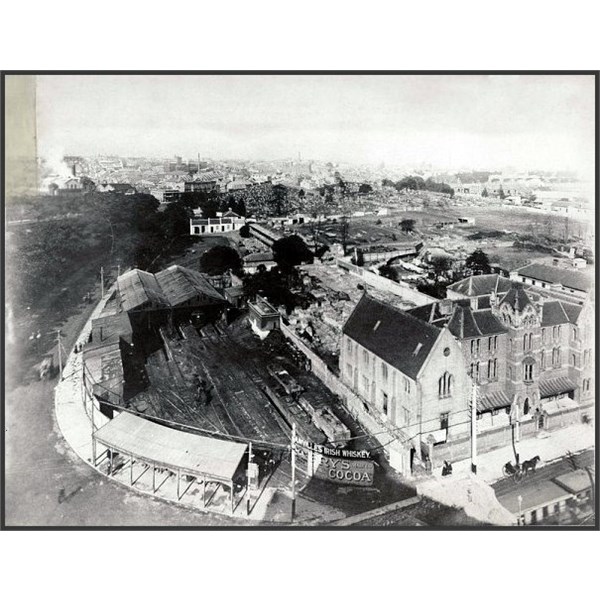
Sydney's first Tramways depot, corner of Pitt Street and what was then Gipps Street West and Garden Road

Tramway Workshops, Randwick 1919
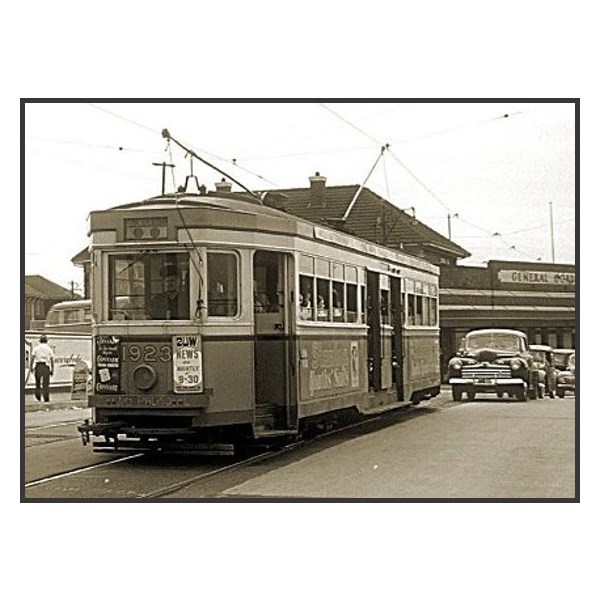
R class no 1923 at Sydenham railway station, 20 November 1954
The workshops grew rapidly to become one of
Sydney's largest engineering establishments peaking in around the 1920s. Reduction in
Sydney tramway diminished the Tramway Workshops functions and led to its eventual closure in 1960/61.
.